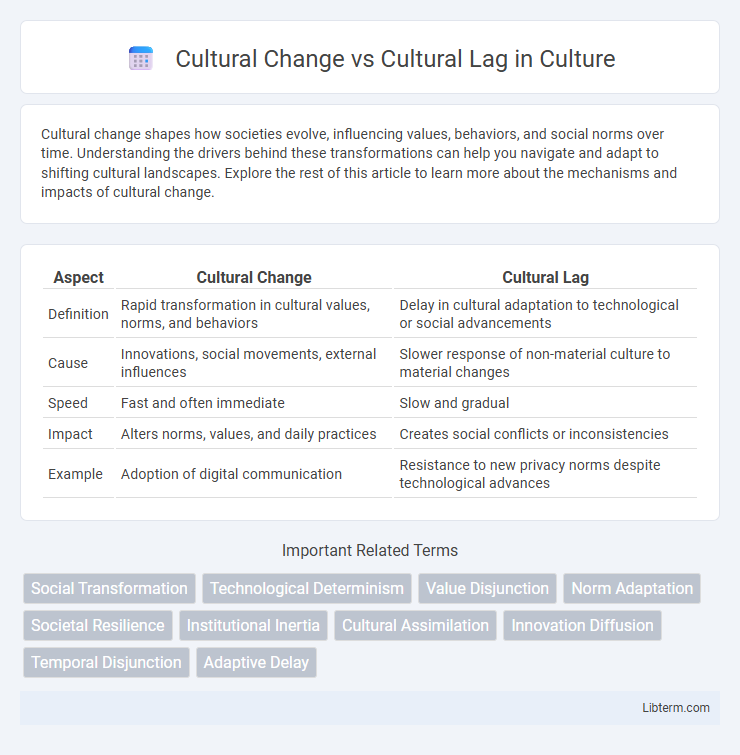Cultural change shapes how societies evolve, influencing values, behaviors, and social norms over time. Understanding the drivers behind these transformations can help you navigate and adapt to shifting cultural landscapes. Explore the rest of this article to learn more about the mechanisms and impacts of cultural change.
Table of Comparison
| Aspect | Cultural Change | Cultural Lag |
|---|---|---|
| Definition | Rapid transformation in cultural values, norms, and behaviors | Delay in cultural adaptation to technological or social advancements |
| Cause | Innovations, social movements, external influences | Slower response of non-material culture to material changes |
| Speed | Fast and often immediate | Slow and gradual |
| Impact | Alters norms, values, and daily practices | Creates social conflicts or inconsistencies |
| Example | Adoption of digital communication | Resistance to new privacy norms despite technological advances |
Understanding Cultural Change: Definition and Dynamics
Cultural change refers to the transformation of a society's cultural patterns, beliefs, practices, and values over time, driven by factors such as technological innovation, social movements, and intercultural contact. The dynamics of cultural change involve processes of diffusion, invention, and adaptation, which reshape social norms and institutions to meet evolving needs. Understanding these forces highlights how cultures evolve continuously while grappling with resistance and the slow pace of modifying established traditions.
Defining Cultural Lag: Meaning and Causes
Cultural lag refers to the period of adjustment when non-material culture struggles to keep pace with rapid changes in material culture, leading to social conflicts or disorientation. This phenomenon often occurs due to technological advancements outpacing legal, ethical, or social frameworks, creating a gap between innovation and societal adaptation. Key causes include resistance to change, inadequate communication channels, and the complexity of aligning new technologies with established cultural norms.
Key Differences Between Cultural Change and Cultural Lag
Cultural change refers to the dynamic process through which cultural elements such as beliefs, values, and technologies evolve over time, while cultural lag describes the delay in cultural adaptation following technological or social innovations. The key difference lies in the timing; cultural change represents proactive or immediate shifts, whereas cultural lag highlights the asynchronous adjustment where non-material culture lags behind material advancements. Understanding these distinctions is crucial in sociology for analyzing how societies cope with rapid technological progress and its impact on social norms.
Drivers of Cultural Change in Modern Societies
Technological advancements, globalization, and shifts in social values are primary drivers of cultural change in modern societies, accelerating adaptations in norms and behaviors. Cultural lag occurs when material culture such as technology evolves faster than non-material culture like laws and ethics, creating temporary social dissonance. Understanding these drivers helps explain how societies navigate the tension between innovation and tradition during periods of rapid transformation.
Examples of Cultural Lag in Technology Adoption
Cultural lag occurs when technological advancements outpace the social and cultural systems that adapt to them, such as the slow integration of privacy norms in response to widespread social media use. Another example includes the delay in regulatory frameworks addressing the ethical implications of artificial intelligence deployment in healthcare. The hesitation to adopt remote work policies during the initial phases of digital communication tools also illustrates this gap between innovation and cultural adaptation.
The Impact of Globalization on Cultural Change
Globalization accelerates cultural change by facilitating rapid exchange of ideas, technologies, and practices across borders, reshaping societal norms and values. Cultural lag occurs when non-material culture, such as beliefs and laws, struggles to adapt to technological advancements introduced through globalization. The growing interconnectedness of economies and communication networks intensifies this dynamic, often leading to tensions between traditional cultural elements and emerging global influences.
How Cultural Lag Affects Social Institutions
Cultural lag occurs when social institutions fail to adapt quickly to technological advancements and changing cultural values, creating gaps between material and non-material culture. This delay impacts institutions such as education, law, and family by enforcing outdated norms and policies that hinder social progress and increase conflicts. The resulting friction can slow societal development and reduce overall cohesion as institutions struggle to reconcile traditional frameworks with emerging realities.
Overcoming Challenges: Bridging Cultural Lag
Overcoming cultural lag requires proactive adaptation strategies that align technological advancements with evolving social values and norms. Emphasizing education and open communication fosters cultural understanding, reducing resistance to change. Implementing inclusive policies accelerates the synchronization between cultural practices and innovations, thereby minimizing societal tension.
Case Studies: Cultural Change vs Cultural Lag in History
The 19th-century Industrial Revolution exemplifies cultural change, where technological advancements rapidly transformed manufacturing and society, fostering urbanization and new social norms. In contrast, the resistance to digital technology adoption in certain traditional communities illustrates cultural lag, where societal values and institutions lag behind technological innovations, causing tension and adaptation challenges. The Civil Rights Movement highlights cultural change as legal and social reforms eventually shifted societal attitudes, while early resistance to these changes depicted cultural lag within social and legal frameworks.
The Future of Culture: Navigating Change and Lag
Cultural change reflects the dynamic evolution of societal values, technologies, and behaviors adapting to modern innovations, while cultural lag highlights the delay in social norms and institutions catching up with these advancements. The future of culture hinges on balancing rapid technological progress with proactive social frameworks to minimize cultural lag and foster seamless integration. Understanding this interplay enables societies to navigate transformations effectively, promoting sustainable cultural development.
Cultural Change Infographic

 libterm.com
libterm.com